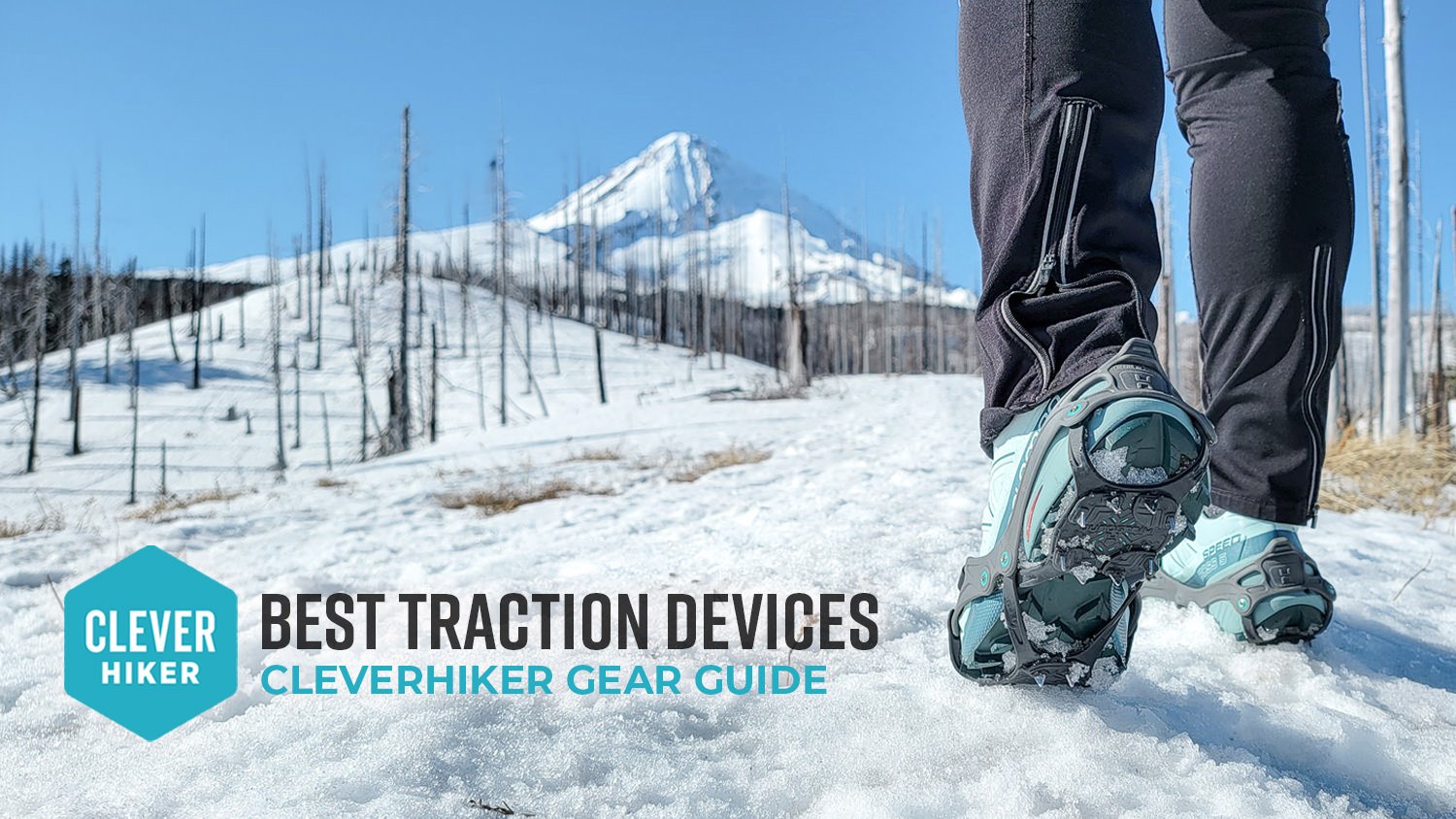
Best Traction Devices for Hiking of 2023
When winter trails freeze over and parking lots look like ice rinks, a pair of traction devices will offer surefootedness and protection from potentially painful missteps.
But when you start looking for the perfect spikes for your snowy adventures, you’ll quickly find that there are an overwhelming number of options out there. Our team of gear experts tested all the best chains and studs on the market to make finding exactly what you need a breeze.
Last updated: September 29, 2023
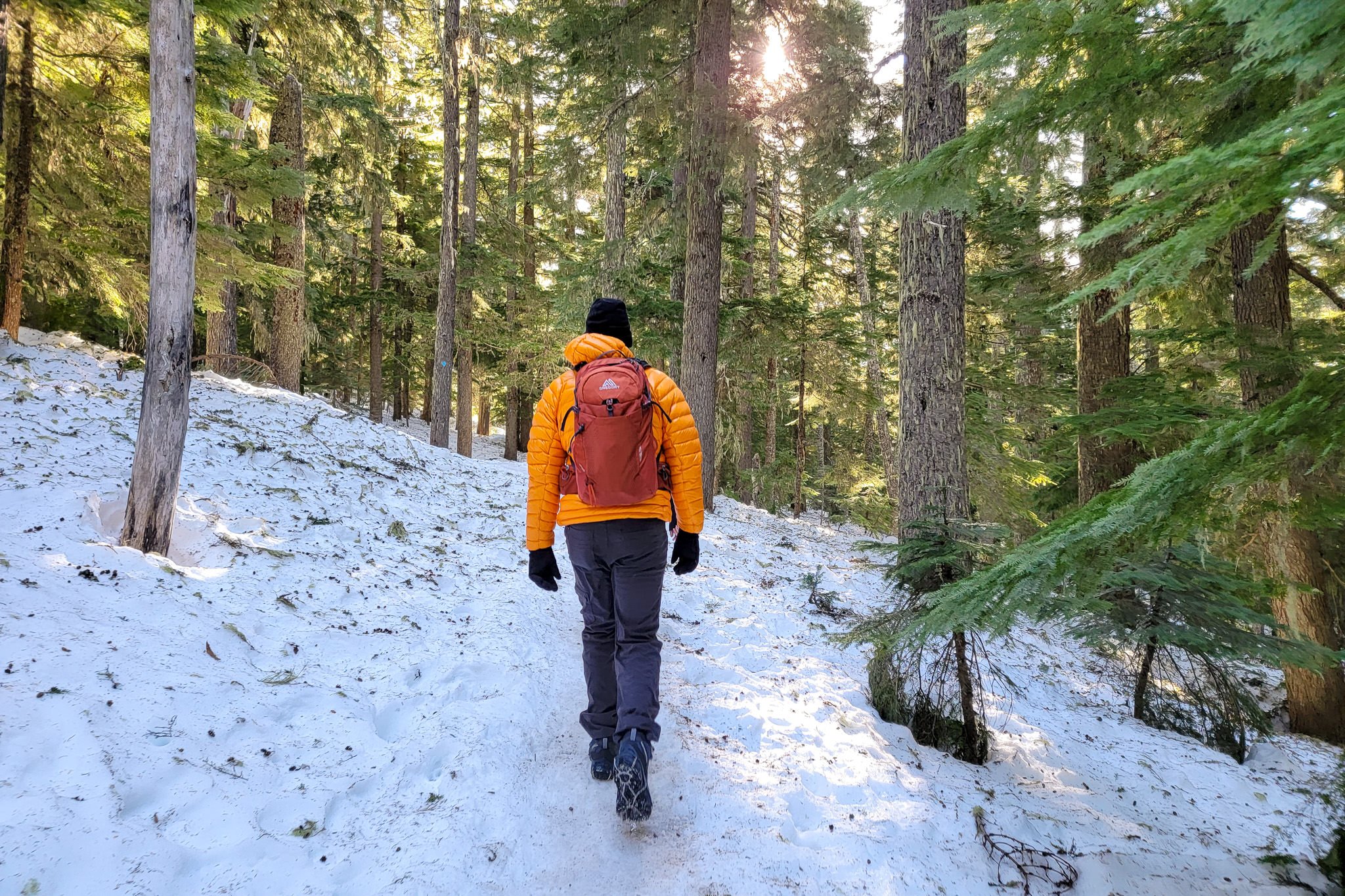
Trade your snowshoes for shoe spikes, like the Snowline Chainsen Trail Light, when snowy trails get hard-packed
Quick Recommendations
Check out this quick list of our favorite traction devices, or continue scrolling to see our full list with in-depth reviews.
- Best traction devices overall for hiking: Kahtoola MICROspikes
- Best traction devices for trail running: Kahtoola EXOspikes
- Best lightweight traction devices: Snowline Chainsen Trail Light
- Best budget traction devices: Yaktrax Diamond Grip
- Comfortable & durable traction devices: Hillsound FlexSteps
- Most aggressive traction devices: Kahtoola K-10
- Ultralight, minimalist traction devices: Snowline Chainsen City
- Heavy-duty traction devices for hiking: Hillsound Trail Crampon
- Low-profile traction devices for urban use: Kahtoola NANOspikes
- Affordable & durable traction devices: Yaktrax Chains
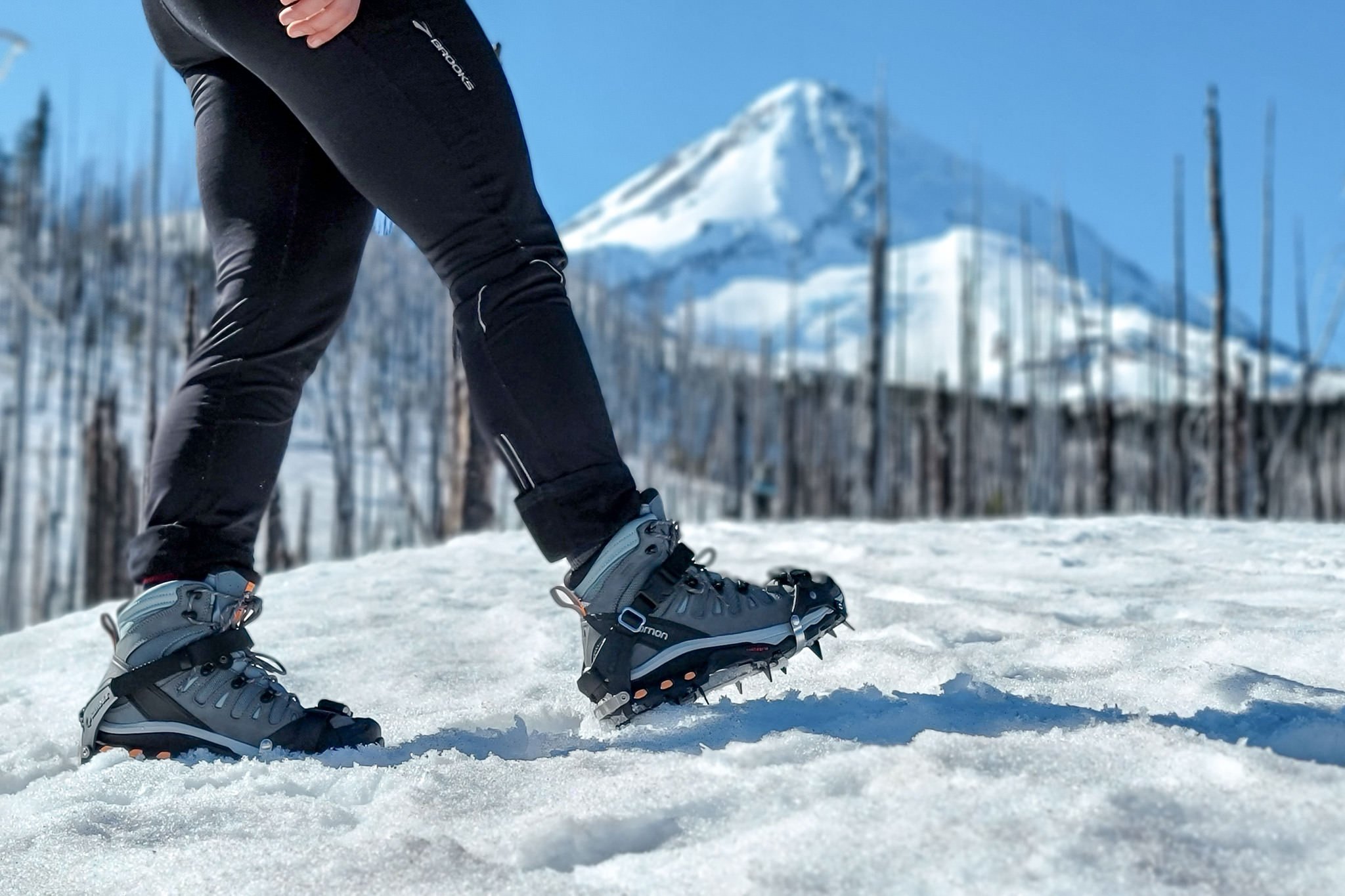
The Kahtoola K-10 provide aggressive traction while allowing you to wear flexible-soled boots
What’s Most Important to You in Traction Devices?
PRICE – You don’t have to spend a lot of money to get a functional pair of traction devices, but we’ve found that you generally get what you pay for when it comes to durability. High-end traction devices tend to have more engineering behind them for a more dialed-in fit and better performance during technical activities like running or backcountry hiking.
- Best value traction devices:Kahtoola MICROspikes, Kahtoola EXOspikes & Hillsound FlexSteps
- Best budget traction devices:Yaktrax Diamond Grip, Snowline Chainsen City & Yaktrax Chains
- Best high-end traction devices:Snowline Chainsen Trail Light, Kahtoola K-10 & Hillsound Trail Crampon
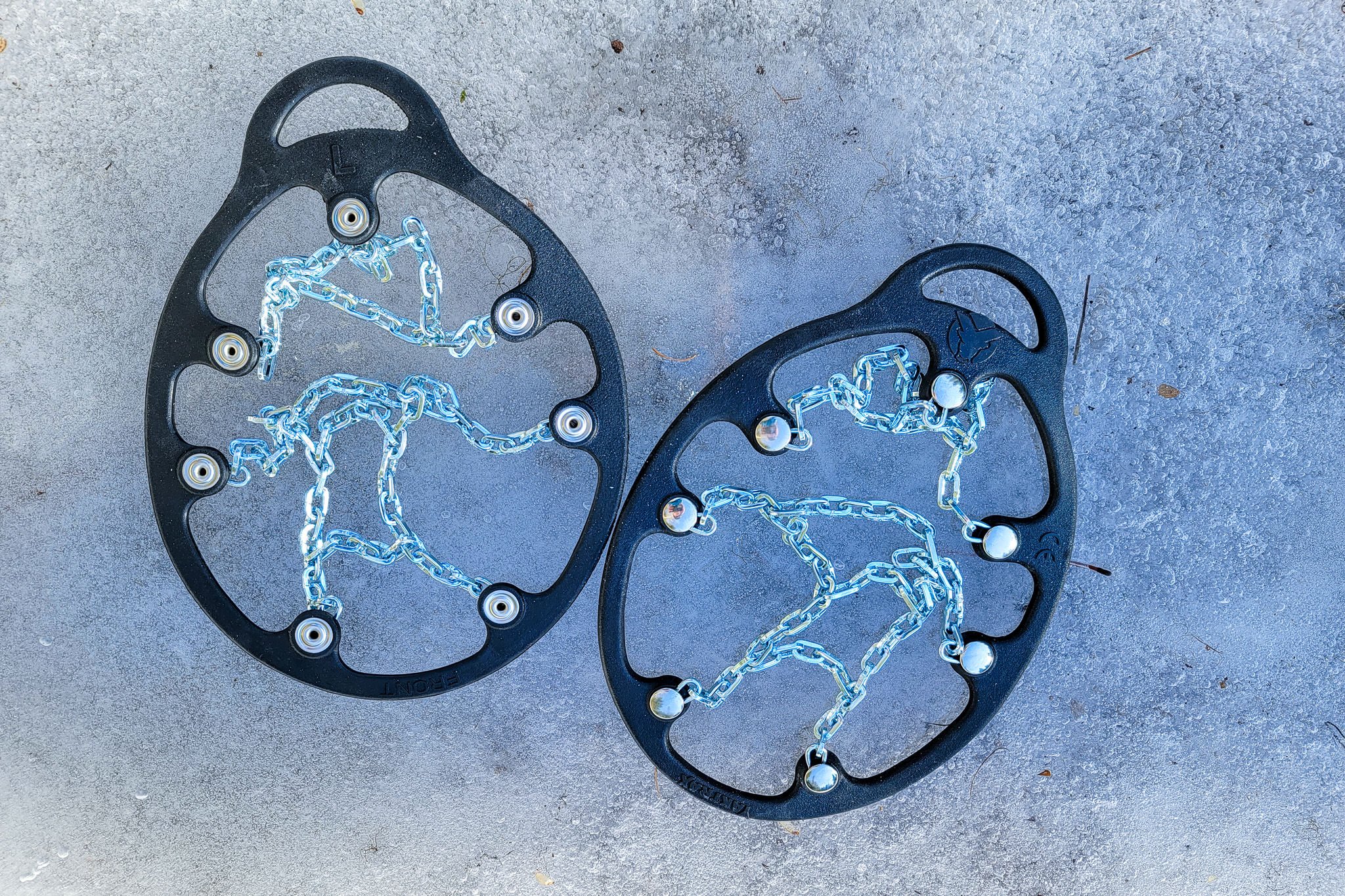
The Yaktrax Chains are durable & affordable, though the fit is more basic than some of the more technical options
WEIGHT/PACKED SIZE – Winter hiking is vigorous exercise, so reducing the weight on your feet can help save energy with every step. Keeping weight and packed size to a minimum is also important if you’ll be carrying your traction devices in a backpack on multi-day trips. Certain situations, like glacier travel or steep ascents, may warrant the need for burlier traction devices with more aggressive spikes. Heavier models tend to be more durable because they’re made with more robust chains and harnesses.
- Best lightweight traction devices: Kahtoola EXOspikes, Snowline Chainsen Trail Light, Snowline Chainsen City & Kahtoola NANOspikes
- Best midweight traction devices: Kahtoola MICROspikes, Yaktrax Diamond Grip, Hillsound FlexSteps & Yaktrax Chains
- Best heavy-duty traction devices: Kahtoola K-10 & Hillsound Trail Crampon
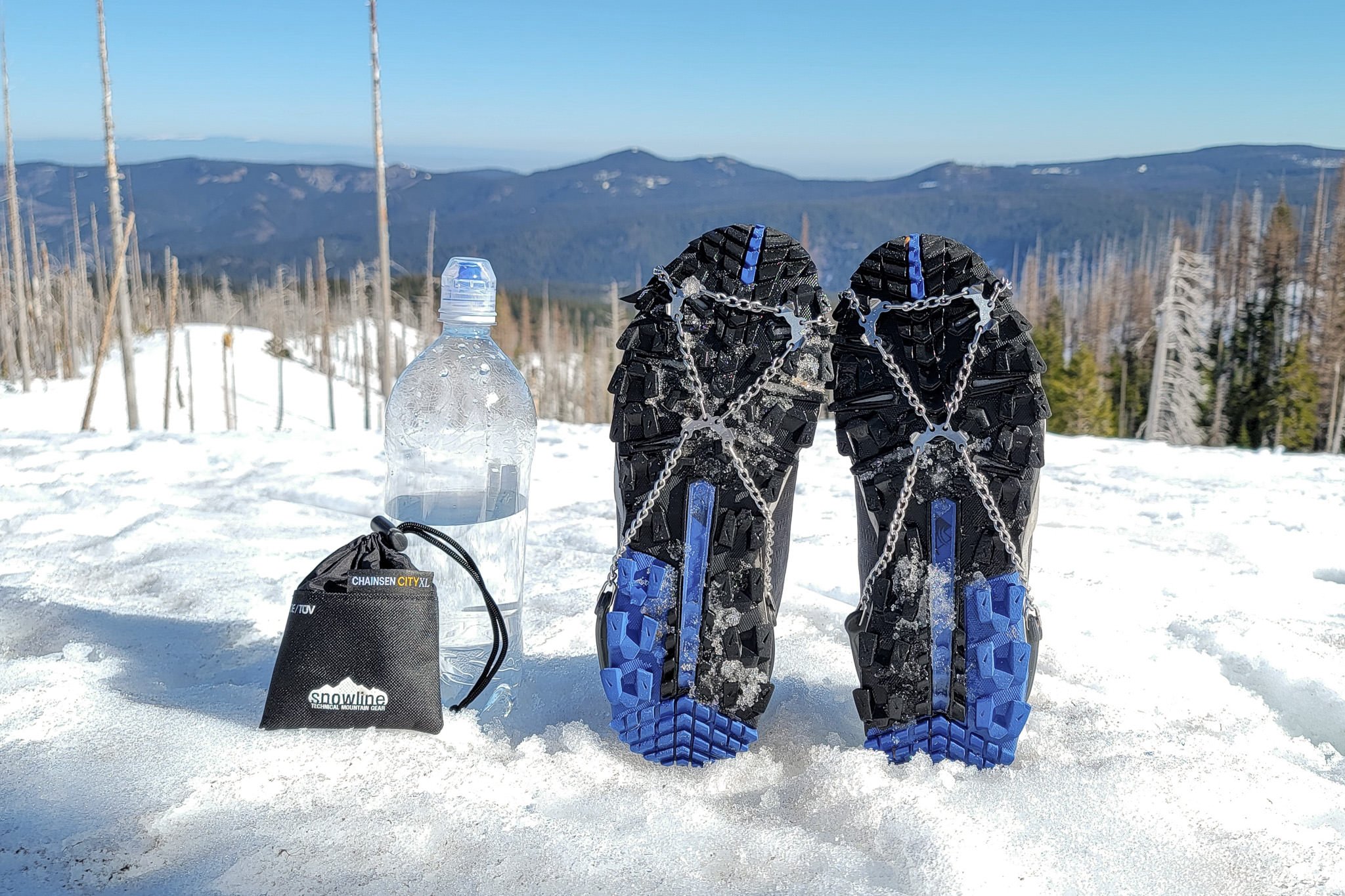
The Snowline Chainsen City traction devices are super lightweight & they fit into a tiny stuff sack
USE – When deciding on a pair of traction devices, it helps to think about the type of terrain you’ll encounter most often. If trail conditions are inconsistent (hard ice, soft snow, rocks, mud), a pair of spikes designed for mixed terrain is your best bet. If you’ll be running or walking on hard-packed surfaces with bare spots (concrete, gravel, etc.), flexible traction devices with low-profile spikes will be the most comfortable. For non-technical mountaineering involving steep climbs and glacier travel, you’ll want a pair of hiking crampons with larger spikes and secure bindings.
- Best traction devices for walking, urban use/flat surfaces:Kahtoola EXOspikes, Yaktrax Diamond Grip, Hillsound FlexSteps, Snowline Chainsen City & Kahtoola NANOspikes
- Best traction devices for hiking/mixed terrain:Kahtoola MICROspikes, Kahtoola EXOspikes, Snowline Chainsen Trail Light, Hillsound FlexSteps & Hillsound Trail Crampon
- Best traction devices for running:Kahtoola EXOspikes, Snowline Chainsen Trail Light & Kahtoola NANOspikes
- Best hiking crampons for alpine terrain:Kahtoola K-10 & Hillsound Trail Crampon
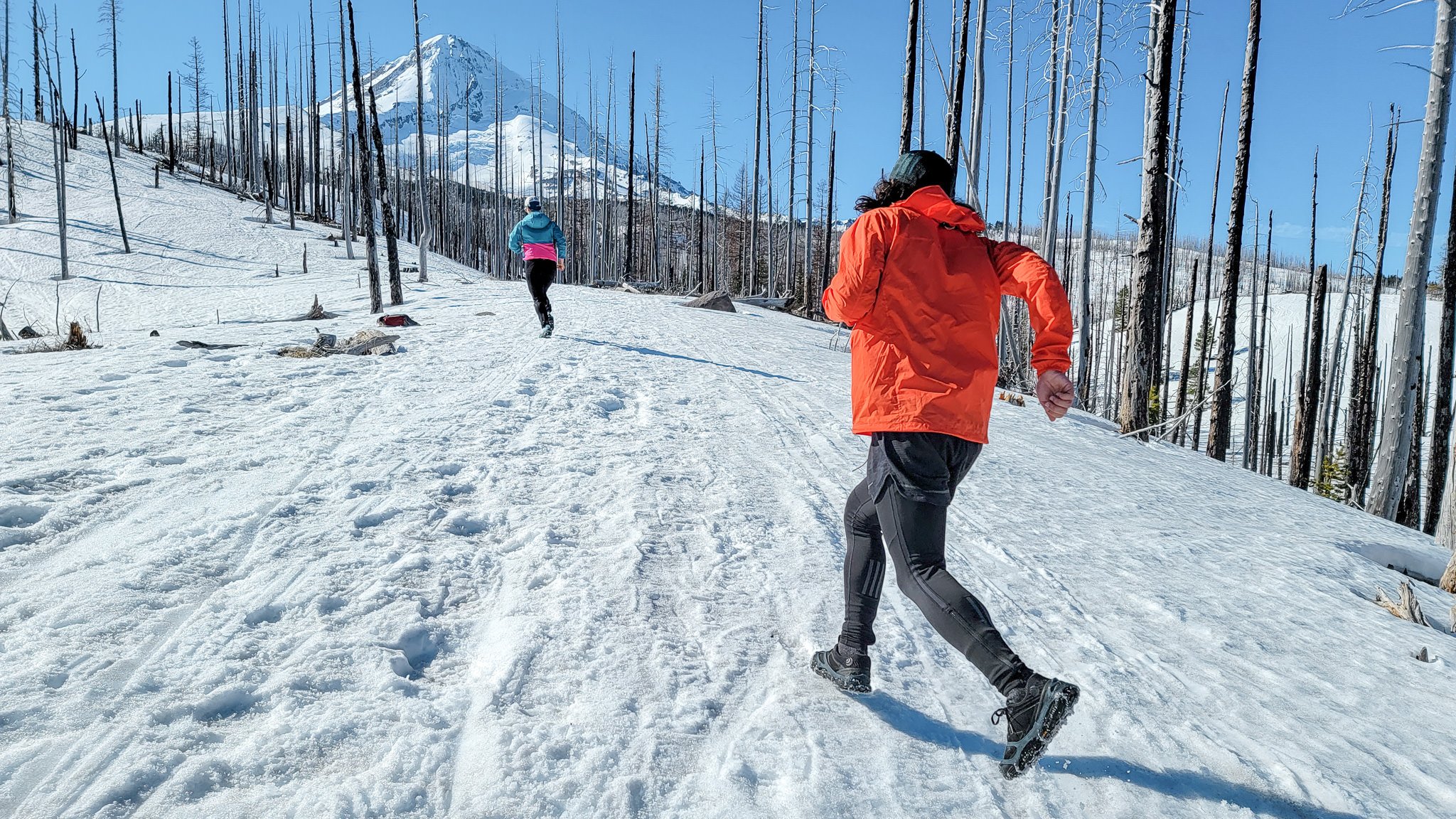
traction devices like the Kahtoola EXOspikes & Snowline Chainsen Trail Light are specifically designed for running
FOOTWEAR COMPATIBILITY – Some traction devices are more compatible with hiking shoes or trail runners, while others are better suited to hiking boots and insulated winter boots. Some models will work with all types of footwear, but it’s critical to check the size chart carefully to make sure you get the proper fit.
- Best traction devices for flexible hiking shoes & trail runners:Kahtoola MICROspikes, Kahtoola EXOspikes, Yaktrax Diamond Grip, Snowline Chainsen Trail Light, Hillsound FlexSteps, Snowline Chainsen City & Kahtoola NANOspikes
- Best traction devices for hiking boots or insulated winter boots:Kahtoola MICROspikes, Yaktrax Diamond Grip, Hillsound FlexSteps, Kahtoola K-10, Hillsound Trail Crampon & Yaktrax Chains
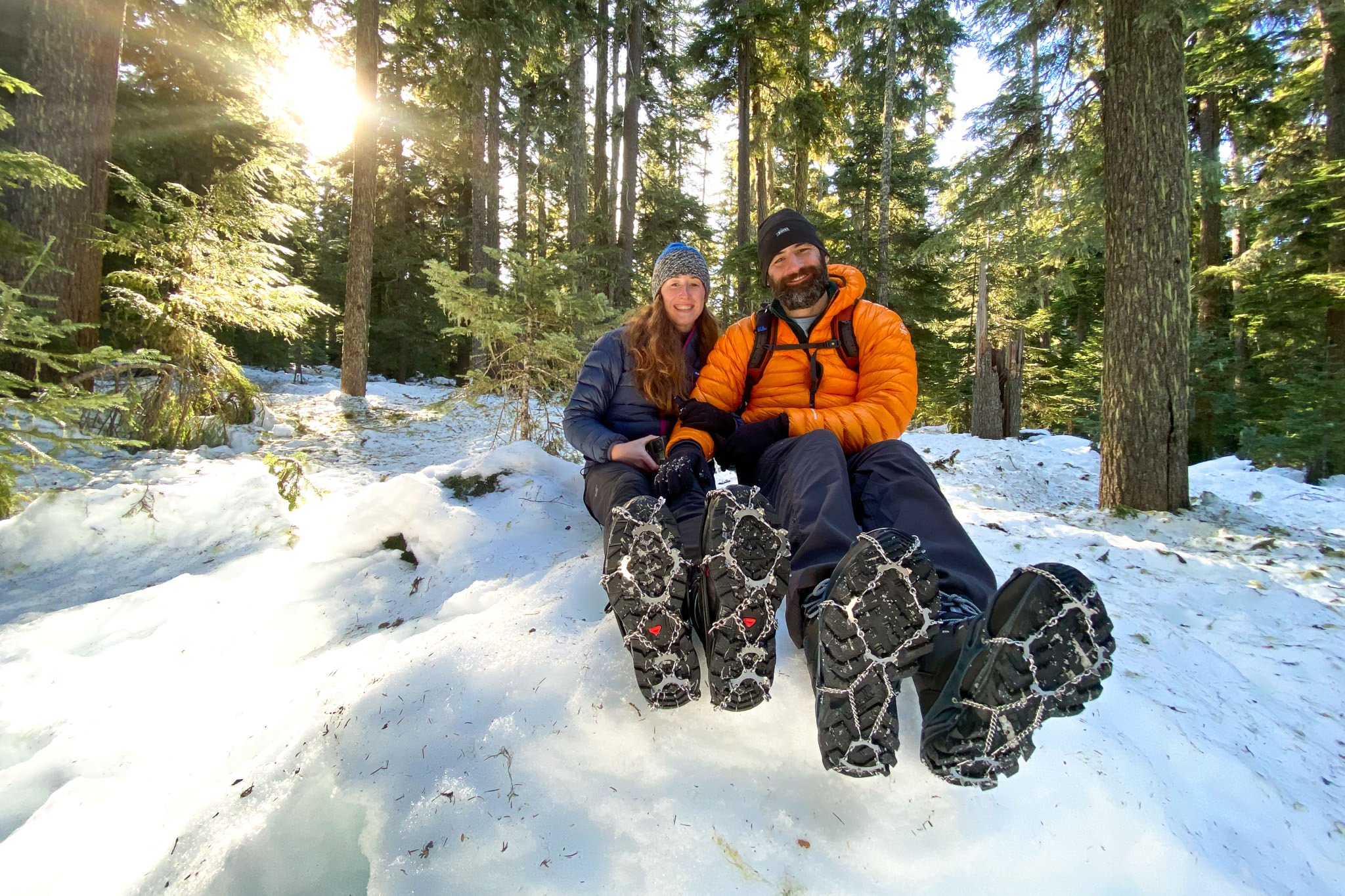
the Kahtoola MICROspikes (left) & Snowline Chainsen Trail Light (right) are compatible with any type of footwear
Best Traction Devices for Hiking of 2023
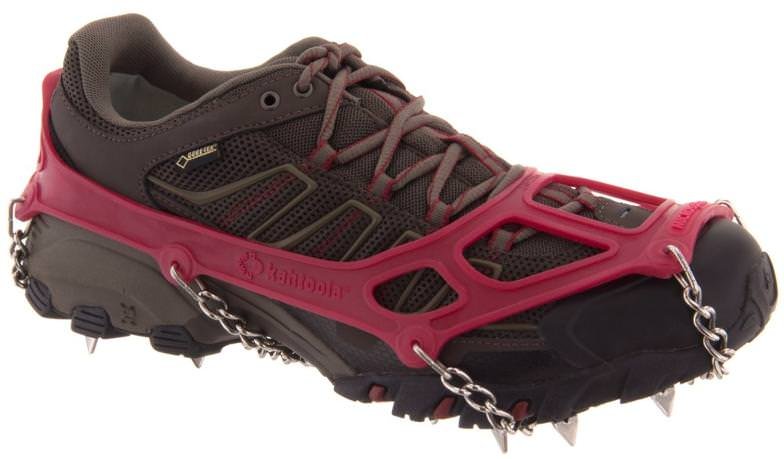
BEST TRACTION DEVICES OVERALL FOR HIKING
MSRP: $75
WEIGHT/PAIR (SIZE M): 11 oz.
BEST USE: Hiking & backpacking; mixed mountain terrain with rocks
PROS: Aggressive traction, durable, relatively compact
CONS: A bit expensive, heavier than some
BOTTOM LINE: The Kahtoola MICROspikes were the first traction devices designed specifically for hikers – a lighter, more approachable version of crampons that work with any shoes. They’re what you’ll find on most hiker’s feet when the snow gets too hard and compacted to travel by snowshoe on high-traffic mountain trails. We like MICROspikes for their aggressive traction and well-balanced ratio of strength to weight. The chain links also make them pack down a bit smaller than those made with more rubber material. There are lighter and cheaper options out there, but you won’t find better quality and durability for mixed mountain terrain than the MICROspikes.
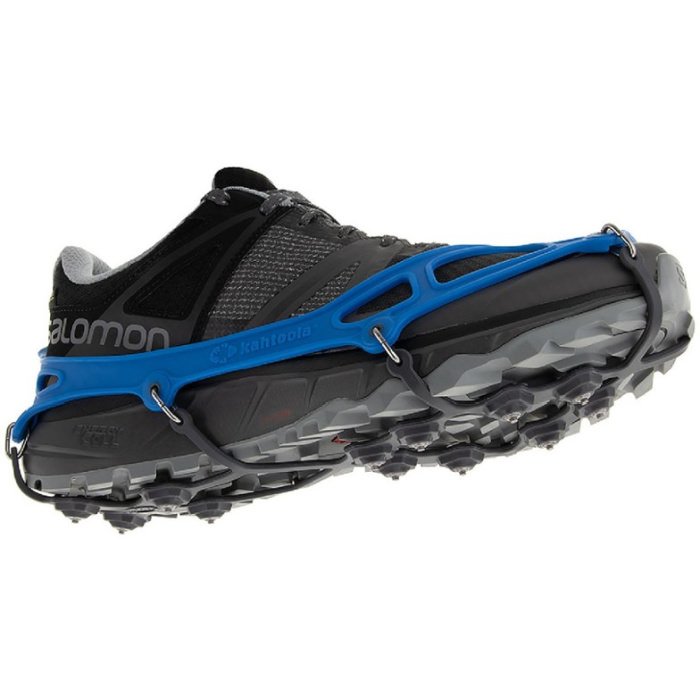
BEST TRACTION DEVICES FOR TRAIL RUNNING
MSRP: $65
WEIGHT/PAIR (SIZE M): 7.3 oz.
BEST USE: Trail running & hiking; mixed ice & hard surfaces
PROS: Versatile, lightweight, comfortable, shock-absorbing, excellent value
CONS: A bit bulkier than some, less aggressive traction
BOTTOM LINE: The Kahtoola EXOspikes are our favorite ice cleats for runners and those looking for lightweight traction to wear with flexible footwear. The carbide studs are super grippy on ice, and their low-profile design makes walking feel natural and comfortable. They won’t make your feet sore like some toothier spikes can when worn for long periods, and they’ll even help soften your impact when running. While the EXOs don’t have quite the same bite on inclines as larger spikes (like the original MICROs), they’re more versatile for everyday wear on terrain from sidewalks to soupy winter trails with patches of snow, ice, and bare ground.
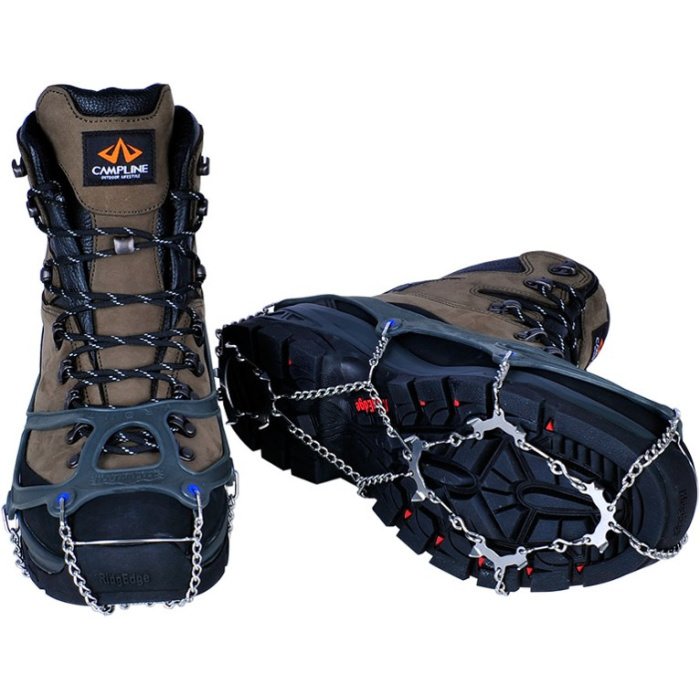
BEST LIGHTWEIGHT TRACTION DEVICES
MSRP: $70
WEIGHT/PAIR (SIZE M): 6.4 oz.
BEST USE: Trail running, hiking & backpacking; packed snow & ice
PROS: Lightweight, compact, fairly aggressive traction, comfortable
CONS: A bit expensive, not as durable as some
BOTTOM LINE: The Snowline Chainsen Trail Light traction devices keep weight to a minimum without skimping on grip. These babies are designed with short, ergonomically-placed spikes for comfortable hiking and trail running. Amazingly, they’re about half the weight of Kahtoola’s popular MICROspikes. Their lightweight chains and thinner harness make them a bit more prone to breakage, so we found that it’s best to avoid rocks and take them off to cross expanses of bare ground. That said, the tradeoff in durability is well worth it for runners looking to minimize energy-sapping weight on their feet and backpackers needing lightweight slip protection for early-season conditions in high-alpine country.
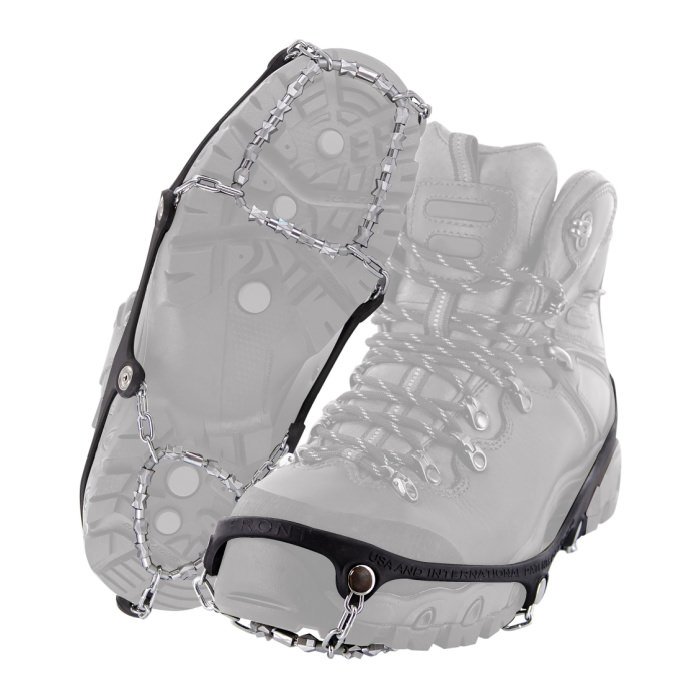
BEST BUDGET TRACTION DEVICES
MSRP: $55
WEIGHT/PAIR (SIZE M): 11.2 oz.
BEST USE: Walking & light hiking; mixed ice, gravel & hard surfaces
PROS: Affordable, comfortable
CONS: Not as durable as some, less aggressive traction, fit not as dialed in, no stuff sack included
BOTTOM LINE: The Yaktrax Diamond Grip are some of the most affordable traction devices on the market, especially since they’re often on sale. They have independently-swiveling steel beads strung on aircraft cable, which prevents the buildup of snow and ice. The Diamond Grips are some of the best performers on transitional surfaces that are often interlaced with snow and ice, like rock, gravel, and concrete. For that reason, we like them for urban walks and light hiking on tame terrain. These traction devices have a much better track record for durability than Yaktrax cheaper offering with the coils – the Walk – but the steel cables on these may also eventually rust or fray. To lengthen their life, allow them to dry after each use. The Diamond Grips offer a great balance of quality and price for those who’ll only use them occasionally.
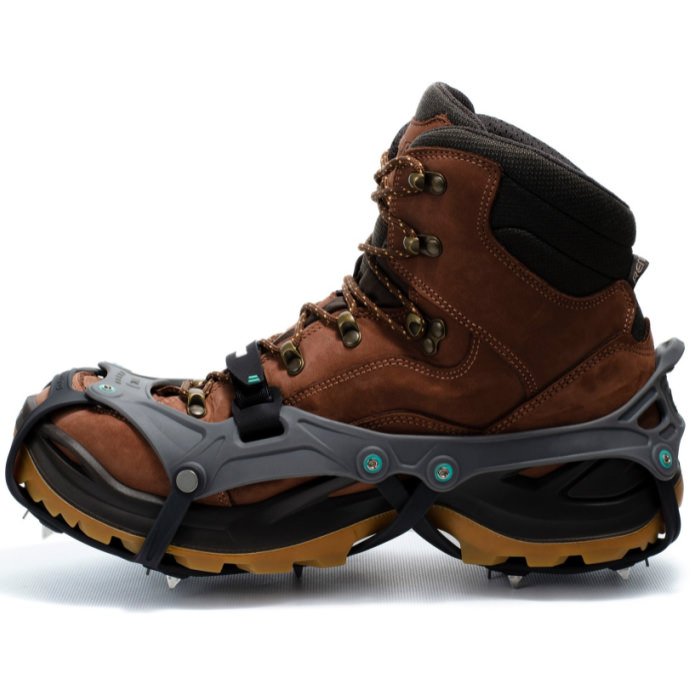
COMFORTABLE & DURABLE TRACTION DEVICES
MSRP: $75
WEIGHT/PAIR (SIZE M): 12.3 oz.
BEST USE: Walking & light hiking; pavement & groomed trails
PROS: Affordable, comfortable, secure fit, easy on/off
CONS: A bit heavier/bulkier than some
BOTTOM LINE: The Hillsound FlexSteps deliver durability, comfort, and a secure fit at an affordable price. The flexible plates and small steel spikes feel unobtrusive when worn with lightweight shoes, and we hardly notice them after miles of hiking on hard-packed snow. They’re easier to put on than some of the stretch harnesses due to the wider opening, and the velcro strap across the top helps hold them securely in place – even if you posthole. We also love the riveted attachment points that won’t come undone like links on chained models might do under stress. There are cheaper, more packable, and more aggressive options out there, but we really like the FlexSteps for their simplicity and dependability.
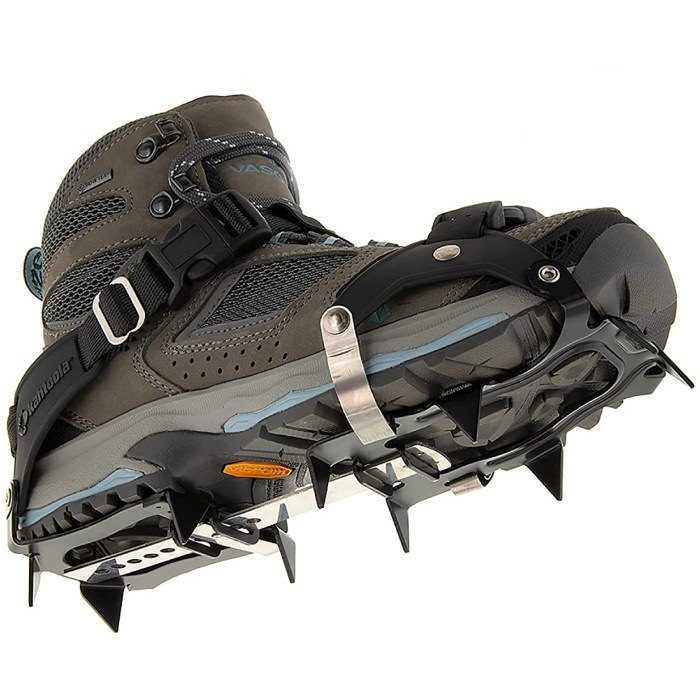
MOST AGGRESSIVE TRACTION DEVICES
MSRP: $120
WEIGHT/PAIR (SIZE REG): 1 lb. 7.6 oz.
BEST USE: Hiking & non-technical mountaineering; hard ice & snow
PROS: Very aggressive traction, flexible, secure fit, easy on/off
CONS: Expensive, a bit heavy/bulky, no stuff sack included, overkill for casual use
BOTTOM LINE: The Kahtoola K-10s sits somewhere in the middle between a shoe chain and a full-fledged mountaineering crampon. The ¾-inch spikes are ideal when you need serious traction to traverse glacier ice, crusted snowpack, or steep alpine snowfields, but they’re overkill for most casual winter hikes. The biggest upside of this type of hiking crampon is that it allows you to wear a comfortable, flexible-soled boot versus conventional crampons that require a rigid mountaineering boot (often made of plastic). The K-10s still aren’t as capable as technical crampons, but they’re much lighter, more packable, and they’re a great happy medium for low-angle mountain climbing and high-alpine routes.
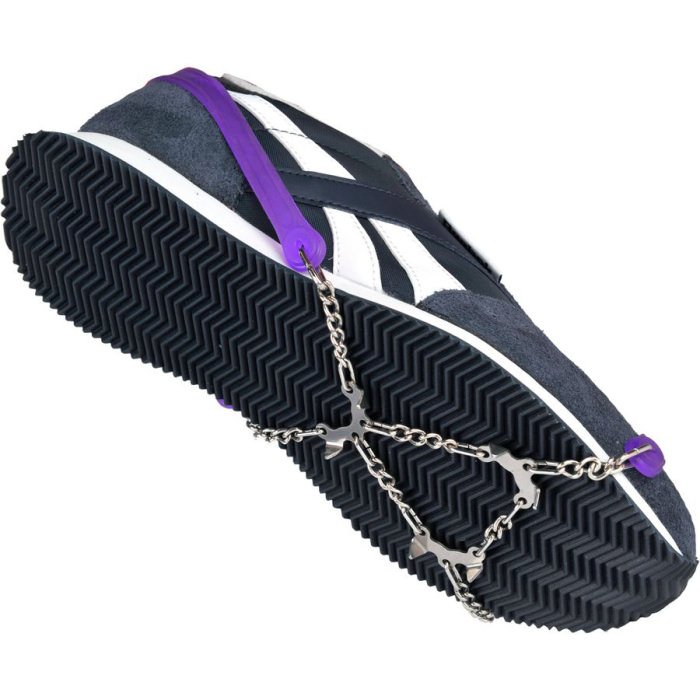
ULTRALIGHT, MINIMALIST TRACTION DEVICES
MSRP: $30
WEIGHT/PAIR (SIZE M): 3 oz.
BEST USE: Walking & light hiking;pavement & groomed trails
PROS: Very affordable, ultralight, very compact, easy on/off
CONS: Not as secure as some, less aggressive traction, less durable than some
BOTTOM LINE: If you’ve been hesitant to pick up traction devices because of the cost or you know you’ll only use them occasionally, check out the Snowline Chainsen City spikes. These are so small and light that you’ll hardly notice them in your fanny pack or daypack, but you’ll be glad you have them when you hit a iced-over section of trail on your daily walk. The simple harness slips over your heel and toe, so proper sizing and a tight fit is everything with these. As the name implies, the Chainsen City are better for tame urban walks than mountain trails. We don’t recommend running in them either because they don’t have as secure a fit as others. That said, we love how light and affordable the Chainsen City are and they still pack a punch when it comes to traction on ice.
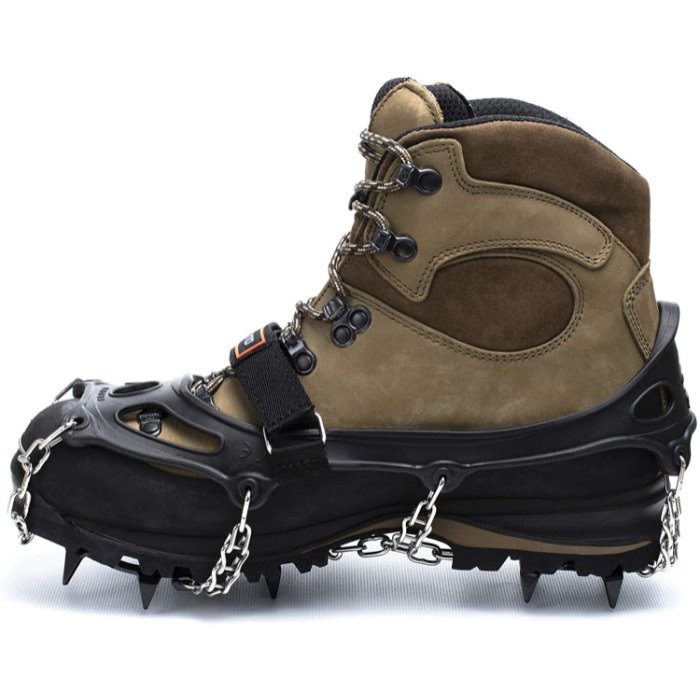
HEAVY-DUTY TRACTION DEVICES FOR HIKING
MSRP: $85
WEIGHT/PAIR (SIZE M): 15.7 oz.
BEST USE: Hiking & backpacking; mixed mountain terrain
PROS: Aggressive traction, durable, secure fit
CONS: A bit expensive, heavier/bulkier than some
BOTTOM LINE: The Hillsound Trail Crampons are all-around solid performers for hiking in mixed mountain terrain. They’re similar to our top pick, the Kahtoola MICROspikes, but they have slightly longer spikes that sit on plates instead of chains to help disperse your weight more evenly. There’s also a velcro strap to increase the security of the stretchy harness. The Trail Crampons are slightly less expensive than the MICROs, but they’re almost 4 oz. heavier and a tad bulkier when packed. Nevertheless, the Hillsounds are an all-around excellent choice if a small increase in weight doesn’t concern you and you like the extra-secure fit the additional strap provides.
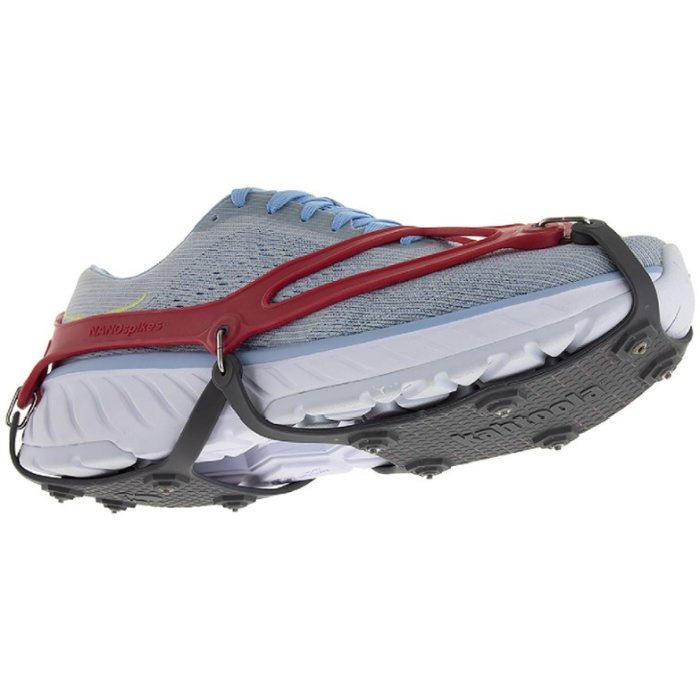
LOW-PROFILE TRACTION DEVICES FOR URBAN USE
MSRP: $55
WEIGHT/PAIR (SIZE M): 8 oz.
BEST USE: Walking & road running; pavement & groomed trails
PROS: Lightweight, affordable, comfortable, shock-absorbing
CONS: Less aggressive traction, not ideal for rugged terrain or inclines
BOTTOM LINE: The Kahtoola NANOspikes are a high-quality, yet affordable choice for urban walking and running. The low-profile grip and flexibility makes them compatible with almost any shoe and comfortable enough to wear all day. Ultimately, we prefer the upgraded EXOspikes for trail running, but the NANOs provide a smoother transition between slick and dry surfaces with their smaller, less numerous carbide studs, so they’re great for mild, around-town outtings.
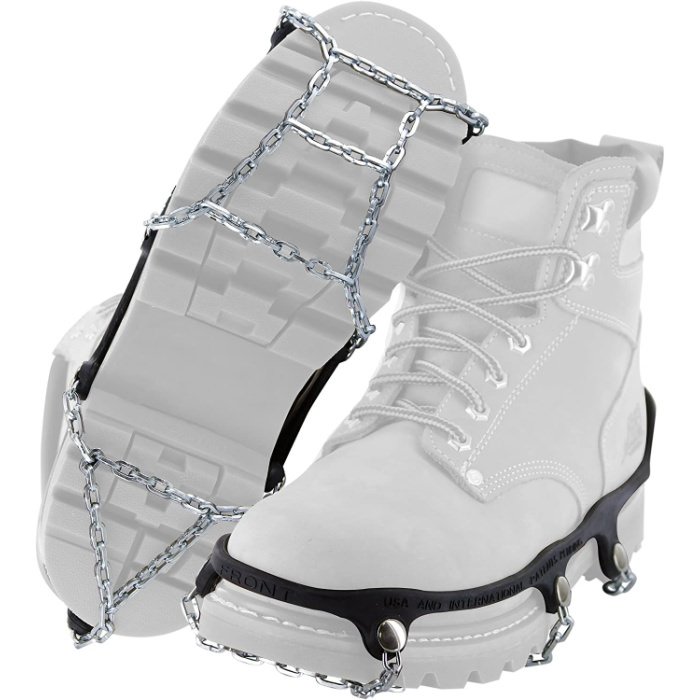
AFFORDABLE & DURABLE TRACTION DEVICES
MSRP: $40 (often on sale for less)
WEIGHT/PAIR (SIZE M): 10.8 oz.
BEST USE: Walking; mixed ice, gravel & hard surfaces
PROS: Very affordable, durable, easy to pack, works well on transitional surfaces
CONS: Heavier than some, less aggressive traction, no stuff sack included
BOTTOM LINE: If you’ll only be walking (not hiking or running), the Yaktrax Chains are a durable and affordable option. They’re made of square chain links with plenty of edges to bite into ice and a ladder pattern for stability on looser snow. What’s truly amazing is that each link is individually welded. That makes the metal components of the Chains pretty darn indestructible! If you have a little room in the budget to upgrade, the Diamond Grips listed above are a little more versatile and trail-ready. But the Chains are more durable long-term and they’re a screaming deal. In addition, some may appreciate that there’s nothing pokey about them, which makes them easy to pack without nicking your backpack.
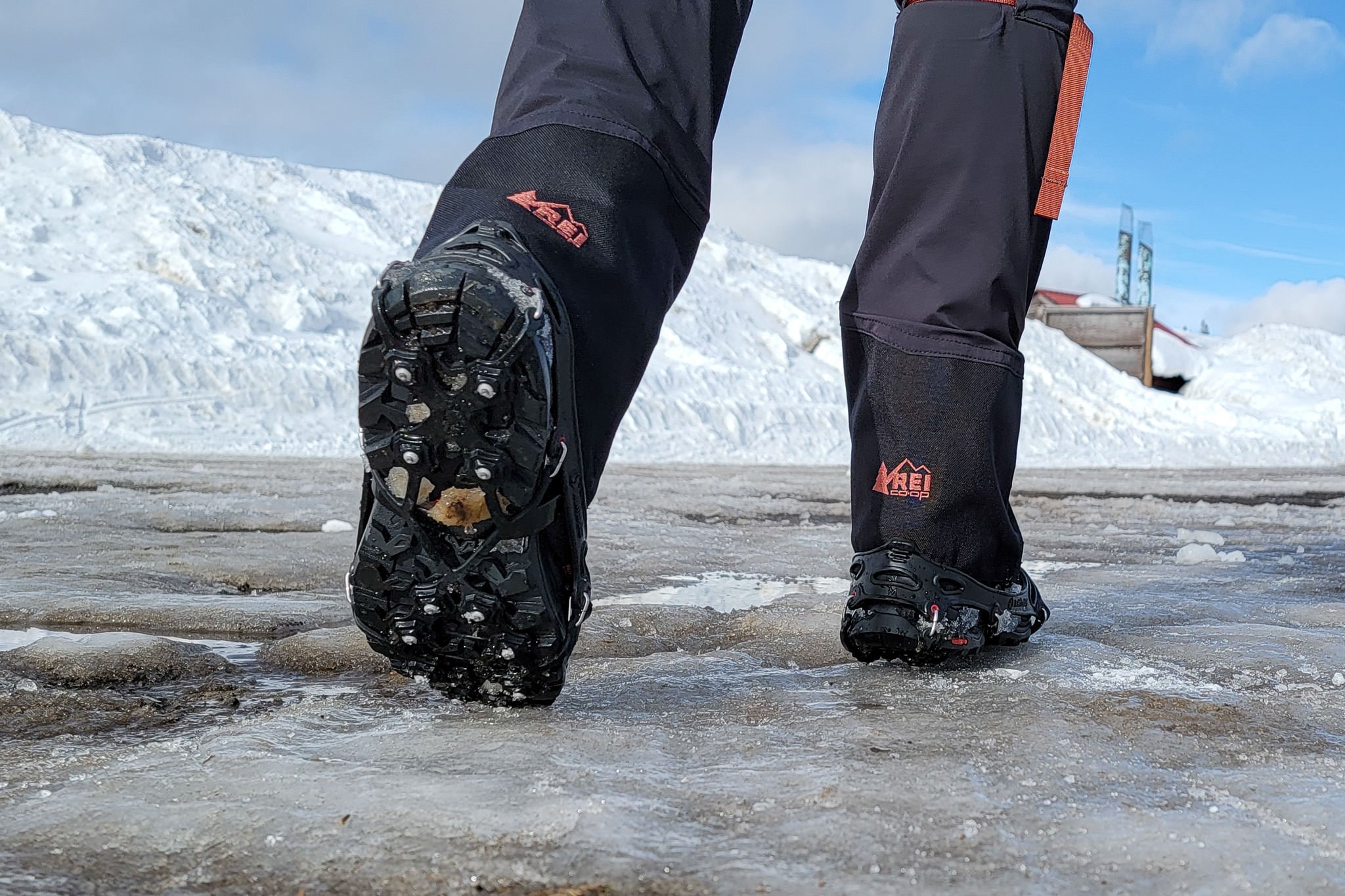
The Kahtoola EXOspikes have low-profile carbide studs that are comfortable & grippy on a variety of surfaces
CRITICAL TRACTION DEVICE CONSIDERATIONS
STORAGE & MAINTENANCE – Traction devices are generally built with rust-resistant metals, but they should be removed from their stuff sack and allowed to air dry completely after each use to keep them at their best. Elastomer harnesses should be kept out of direct sunlight when stored since UV light will cause them to age more quickly.
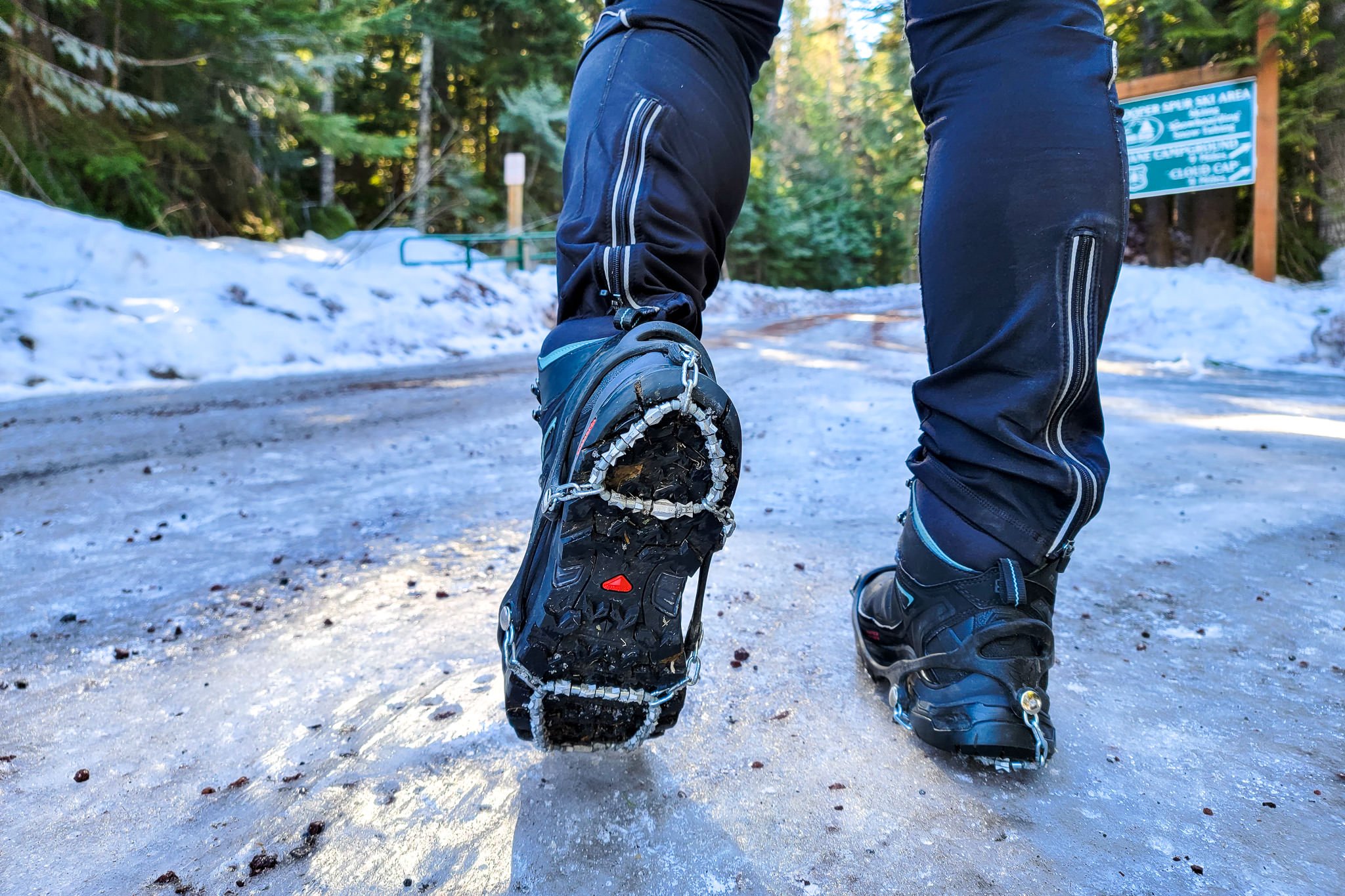
The Yaktrax Diamond Grip are affordable, low-profile & they work well from town to trail
WATCH THOSE SHOELACES – We’ve learned that it’s really important to tie and tuck shoelaces securely to avoid catching them on the spikes of traction devices. To avoid painful mishaps, make sure to double-knot your laces and fold all loops under the tongue of your shoe/boot before setting out on any hike.
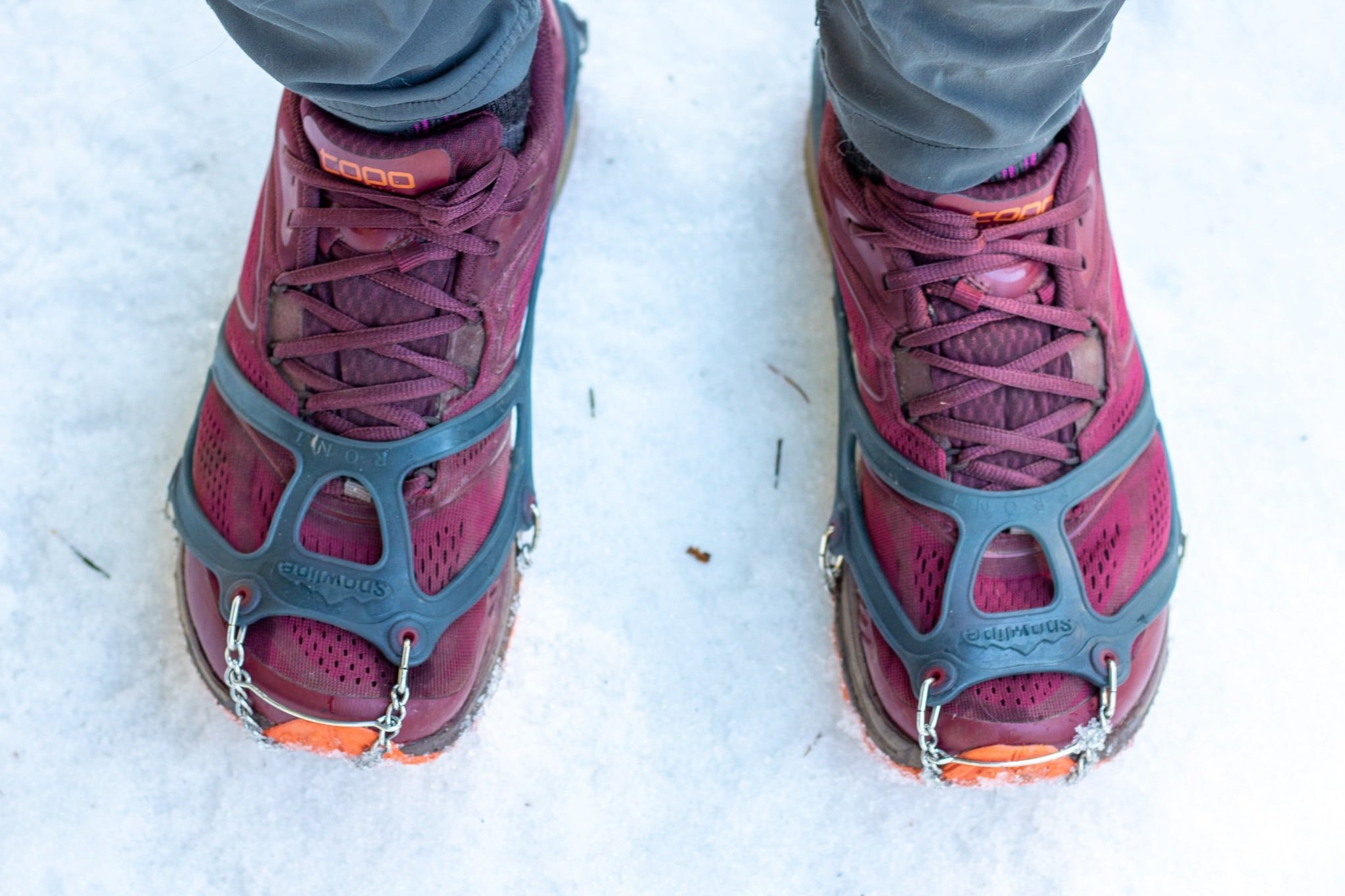
The Snowline Chainsen Trail Light work great with trail running shoes, just make sure to tuck your laces securely
BE PREPARED FOR REPAIRS – Most of the traction devices on this list are built tough, but your spikes will take quite the beating in mixed terrain with rocks, snow, ice, and other transitional surfaces. We recommend carrying a small multitool with pliers and possibly a few zip ties in case you need to do a minor repair while you’re out. To prevent breaks from happening, avoid stepping on rocks when possible and take your traction devices off when crossing expansive stretches of dry trail, gravel, or pavement.
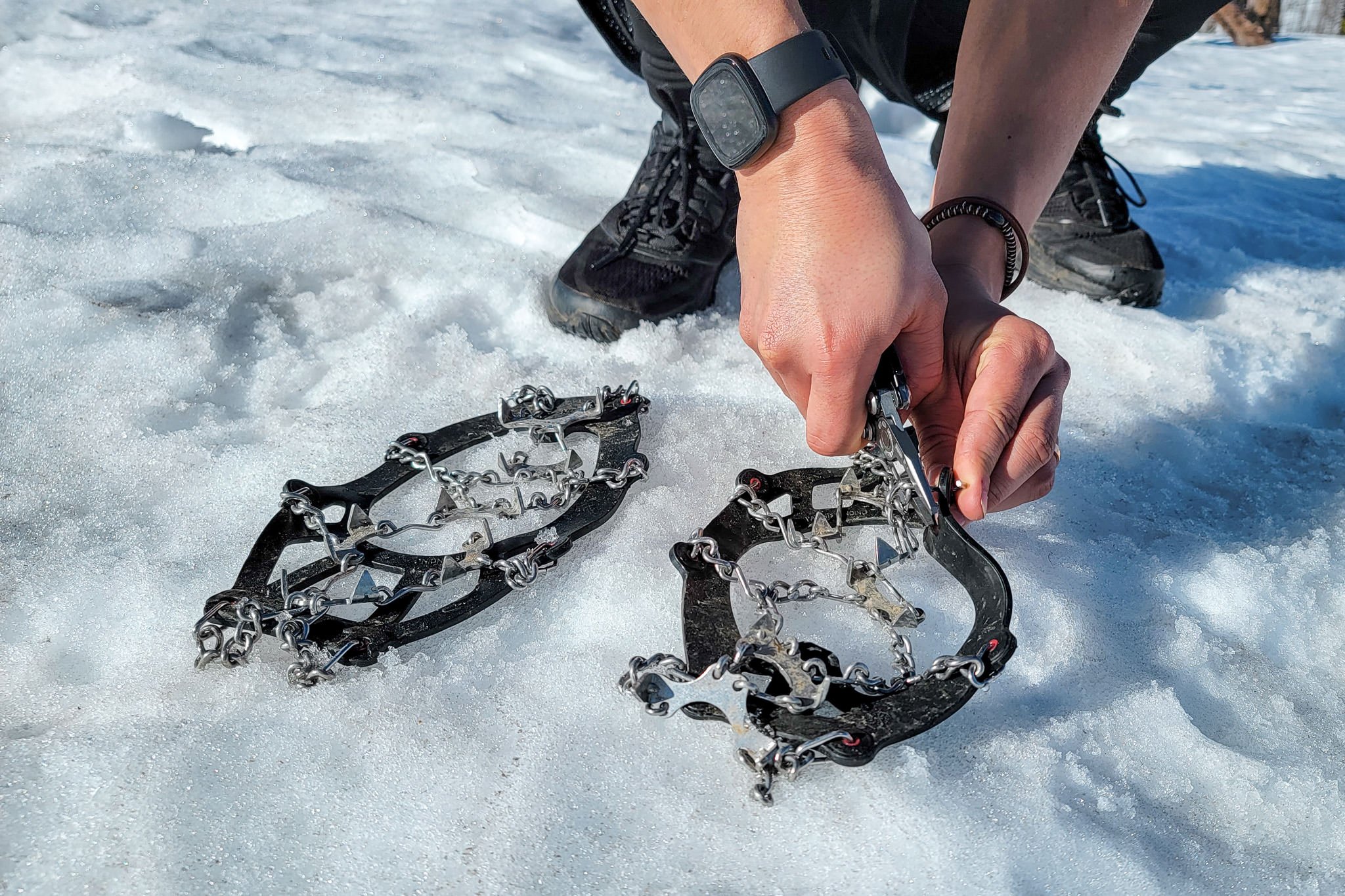
It’s a good idea to carry a multitool with pliers when using traction devices with chains like the Kahtoola MICROspikes
Need More Gear Advice?
If you liked this list, you’ll love the CleverHiker Gear Guide where we test and recommend tons of outdoor adventure gear from a variety of categories. here are some links to popular articles:
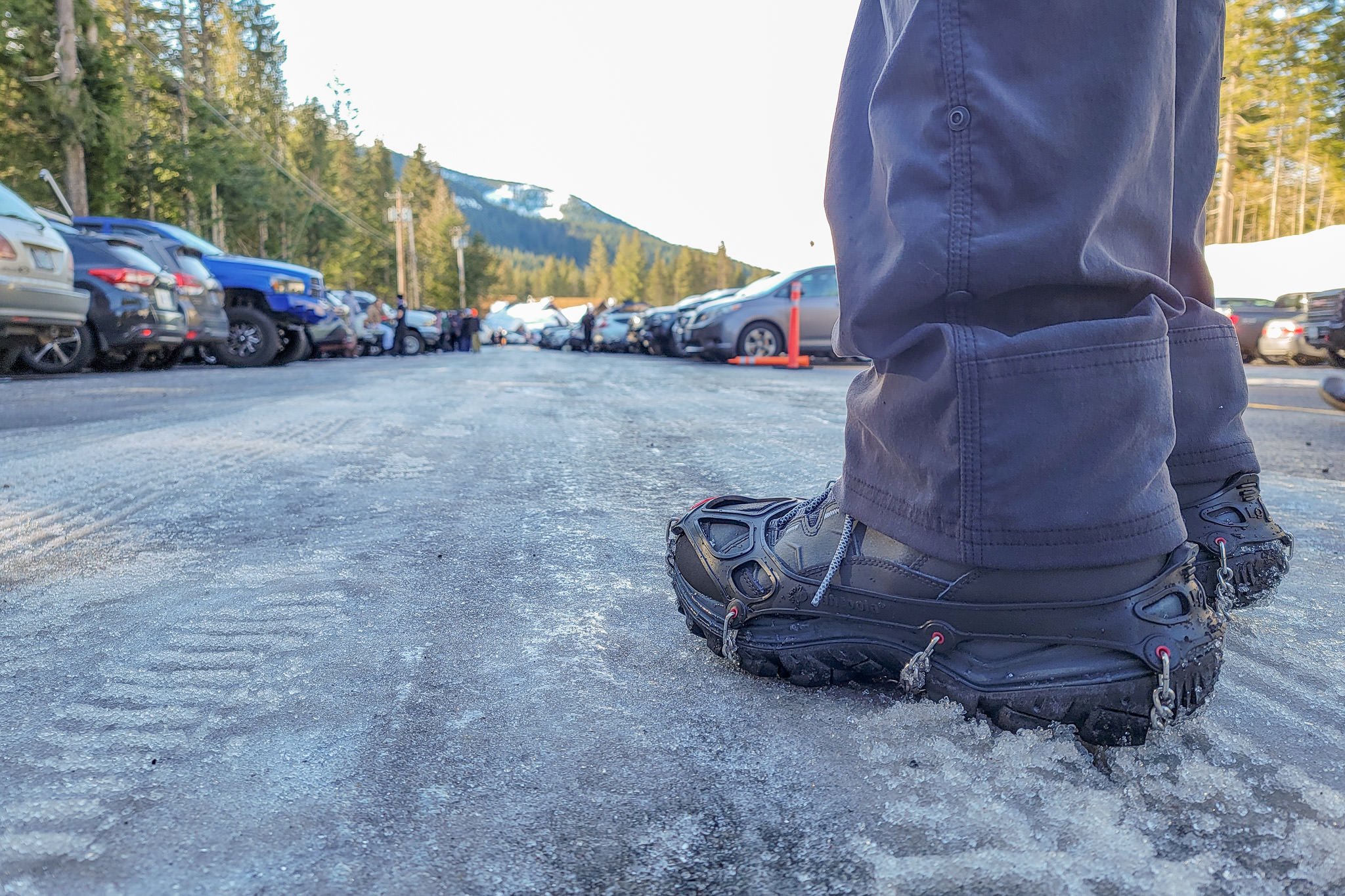
the Kahtoola MICROspikes are great for everything from early-season backpacking to crossing icy parking lots
Why Trust Us?
We fully understand how tough it is to find trustworthy gear advice, and that’s one of the main reasons we built CleverHiker. We live for outdoor adventure, and we take these guides very seriously. Here are some of the reasons you can trust us:
- Our choices are completely independent and based on personal experience.
- We’ve logged over 10,000 trail miles and test outdoor gear for a living.
- We own and field test every product we recommend, which is sadly not the norm.
- We travel to industry trade shows to learn about upcoming product innovations.
- We constantly update our guides when new products launch.
- We treat our recommendations as if they were for our family and friends.
- We’re lifelong learners and we’re always open to constructive criticism. If you think we’ve missed a product or got something wrong, we’d love to hear your feedback.
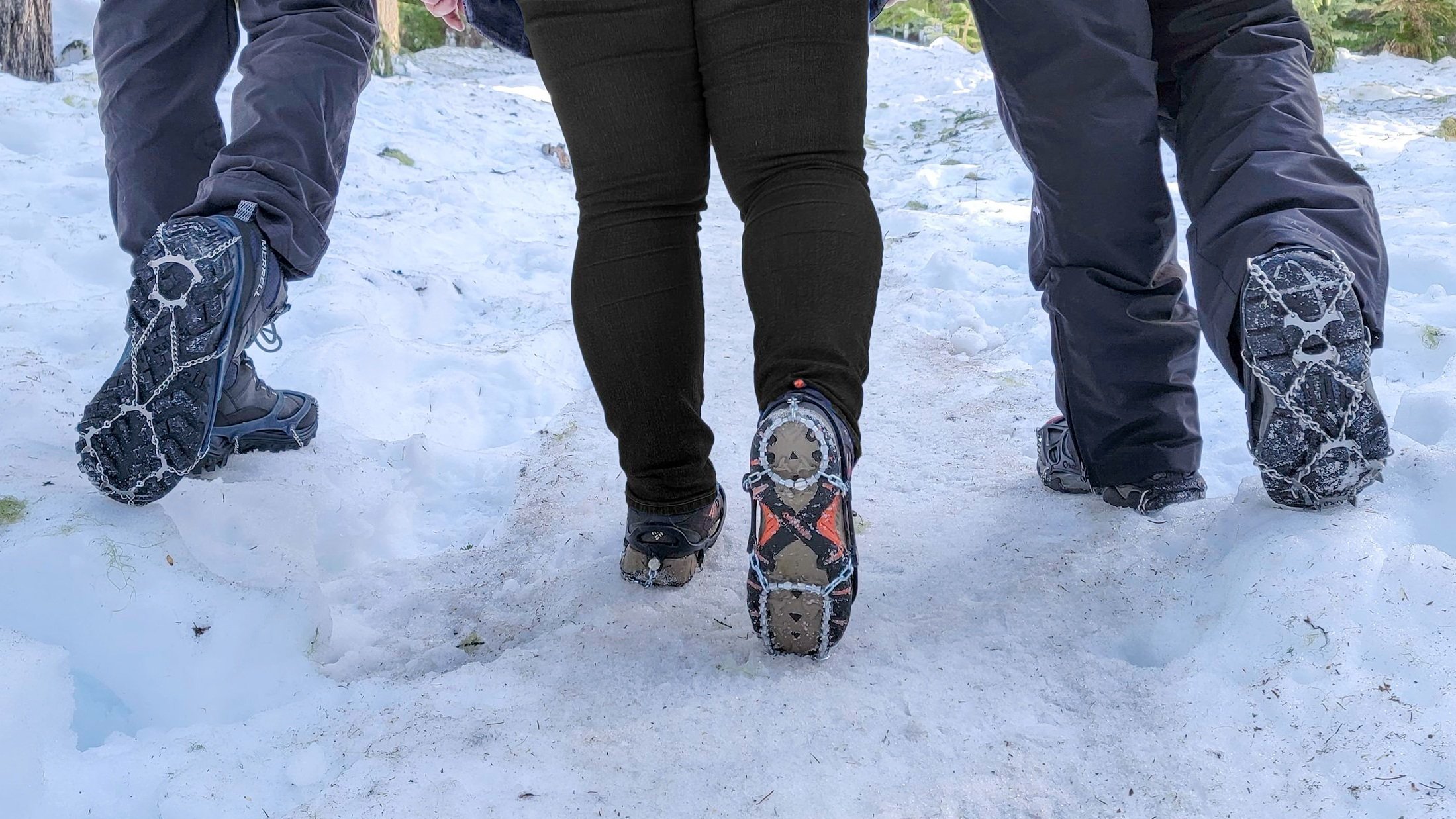
Snowline Chainsen Trail Light (left), Yaktrax Diamond Grip (middle) & Kahtoola MICROspikes (right)
MORE INFORMATION
We hope this guide helps you find the perfect gear for your needs. If you have more questions or a suggestion, we’d love to hear from you! Sign up for our newsletter to stay updated on our latest posts then visit our Facebook page and Instagram to join the community conversation.
If you found this guide helpful, please give it a share on social media! Also, be sure to check out our CleverHiker Gear Guide to see all of our top gear picks.
Thanks for reading and happy trails!
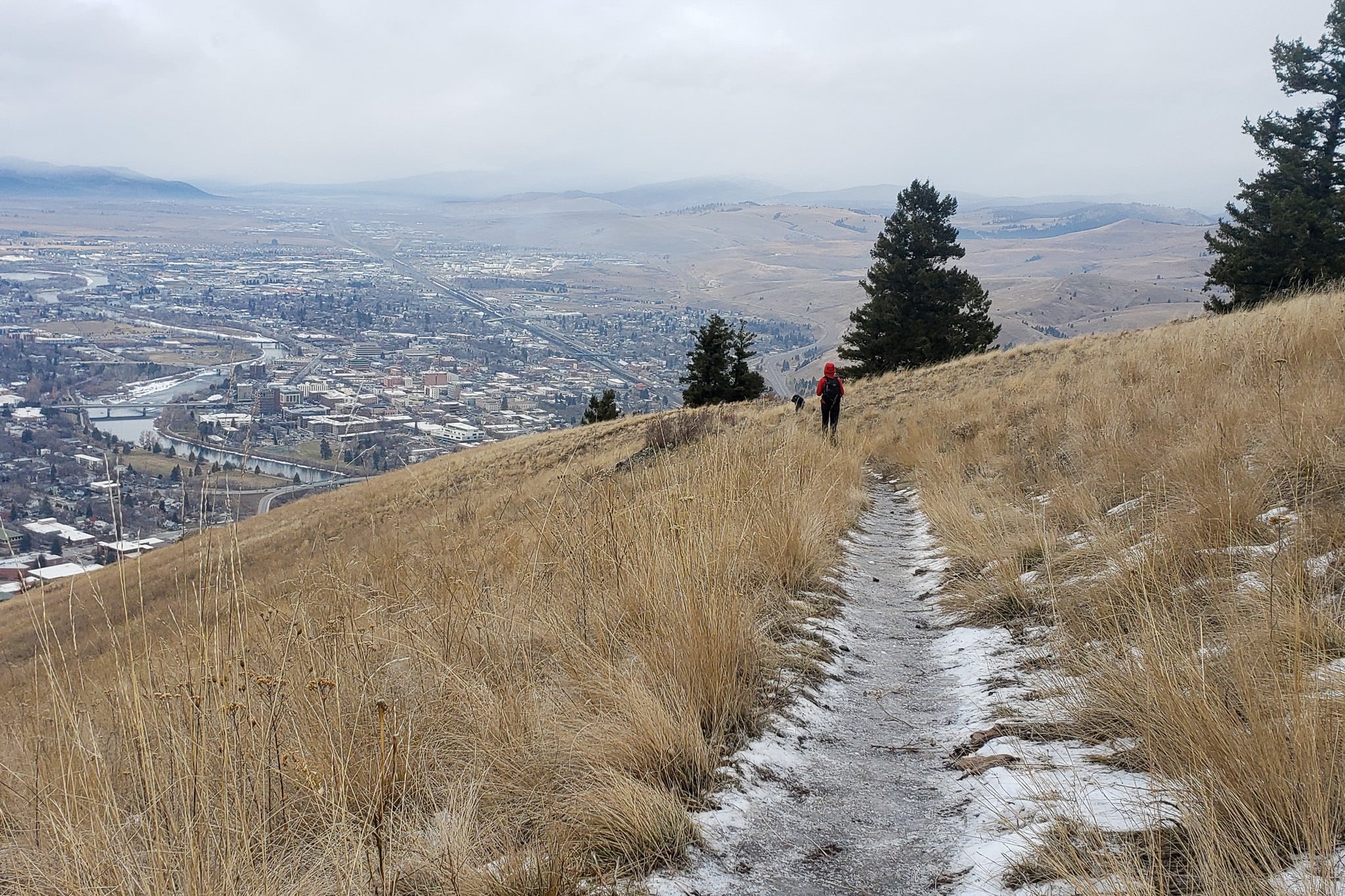
An icy trail overlooking Missoula, MT
Some of the links on this page are affiliate links, which means we may receive a modest commission if purchases are made through those links. This adds no cost to our readers and helps us keep our site up and running. Our reputation is our most important asset, which is why we only provide completely honest and unbiased recommendations.


